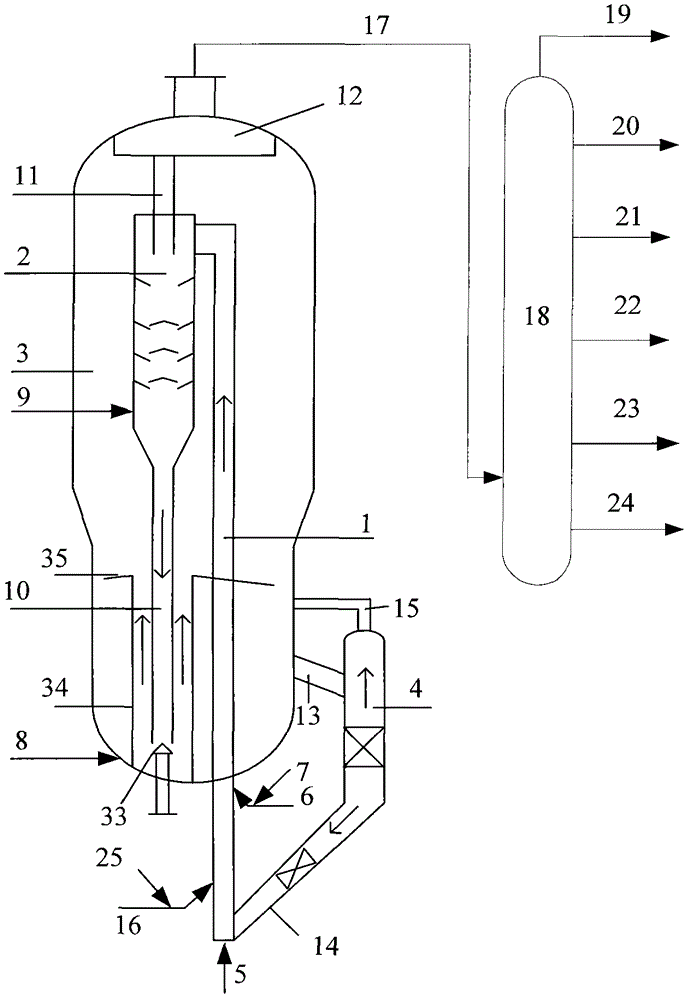Method for producing low carbon olefin by catalytic conversion of lightweight petroleum hydrocarbon
A technology for catalytic conversion and low-carbon olefins, which is applied in the field of light hydrocarbon oil catalytic conversion to produce low-carbon olefins. It can solve the problems of high conversion rate of cracking reaction, insufficient reaction heat, and large water vapor consumption, etc. Yield, avoidance of non-selective reactions, effects on mitigating heat balance problems
- Summary
- Abstract
- Description
- Claims
- Application Information
AI Technical Summary
Problems solved by technology
Method used
Image
Examples
specific Embodiment approach
[0019] The regenerated catalyst rich in mesoporous zeolite enters the pre-lift section of the riser reactor, and flows upward under the action of the pre-lift medium, and the preheated light hydrocarbon oil feedstock is injected into the lower part of the riser reactor together with the atomized steam. The regenerated catalyst is in contact with the catalytic cracking reaction and flows upwards at the same time; the reacted stream enters the cyclone separator through the outlet of the riser reactor for gas-solid separation, and the separated reaction oil and gas extraction device is further separated to obtain ethylene, propylene, C2-C3 alkanes and C4 and other products; the separated raw catalyst with charcoal directly enters the stripping section at the lower end of the cyclone separator, and after stripping, enters the catalyst regenerator for burnt regeneration, and the regenerated catalyst that restores activity is returned to the riser reactor for recycling;
[0020] The...
Embodiment
[0048] This embodiment is tested according to the flow process of the accompanying drawing, using straight-run naphtha as raw material, the test is carried out on the medium-sized device of the riser reactor, the preheated raw material oil enters the bottom of the riser, and at a reaction temperature of 675 ° C and a reaction time 2.5 seconds, the weight ratio of catalytic cracking catalyst to feedstock oil is 30, and the weight ratio of water vapor to feedstock oil is 0.45 to carry out the cracking reaction. The reaction product, steam and unborn catalyst enter the closed cyclone from the reactor outlet. The reaction product and the catalyst are quickly separated, and the reaction product is cut according to the distillation range in the separation system after exchanging heat with the raw material, so as to obtain fractions such as dry gas, propylene, C4 and gasoline, among which C4 returns to the reactor for further cracking into ethylene and propylene. The raw catalyst ent...
PUM
 Login to View More
Login to View More Abstract
Description
Claims
Application Information
 Login to View More
Login to View More - Generate Ideas
- Intellectual Property
- Life Sciences
- Materials
- Tech Scout
- Unparalleled Data Quality
- Higher Quality Content
- 60% Fewer Hallucinations
Browse by: Latest US Patents, China's latest patents, Technical Efficacy Thesaurus, Application Domain, Technology Topic, Popular Technical Reports.
© 2025 PatSnap. All rights reserved.Legal|Privacy policy|Modern Slavery Act Transparency Statement|Sitemap|About US| Contact US: help@patsnap.com

